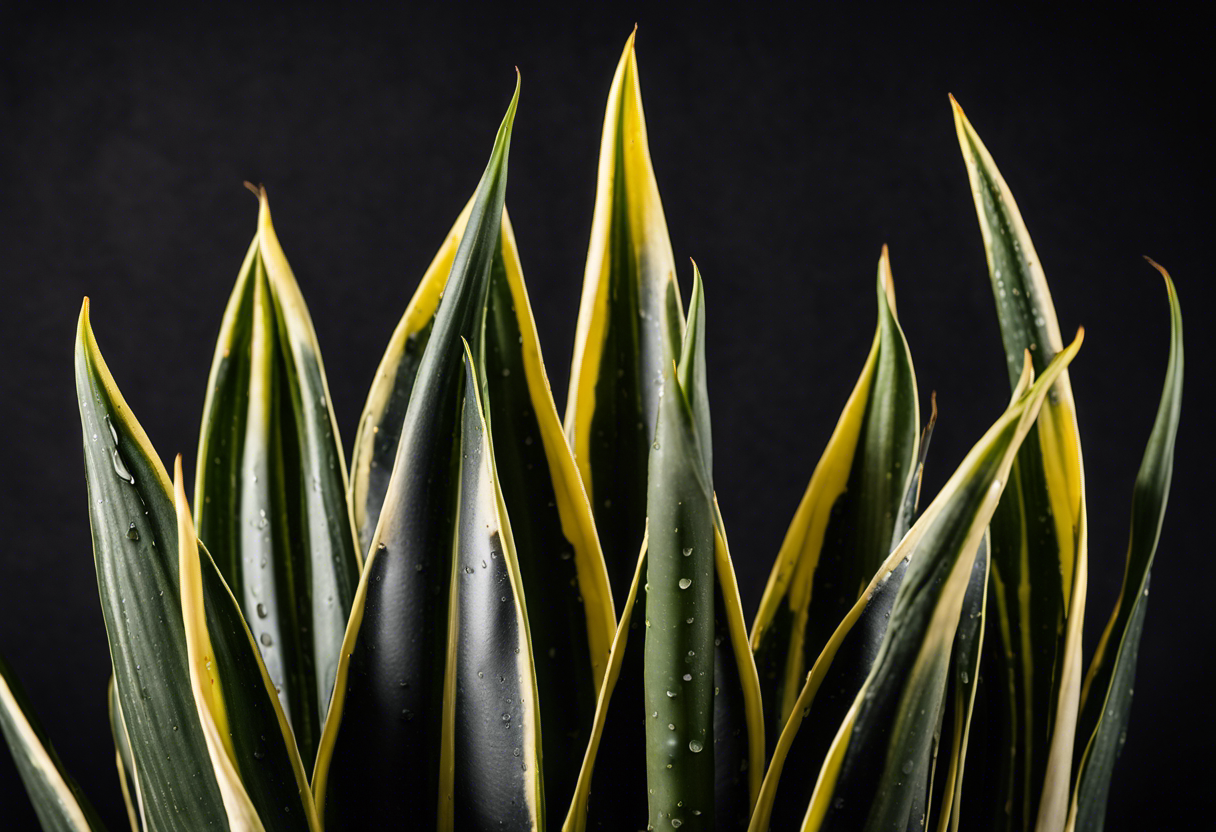Ever had that sinking feeling when you see your beloved snake plant’s leaves starting to droop? It’s like watching a superhero lose their powers, right? Well, don’t panic just yet! I’m here to guide you on how to Save a Snake Plant With Drooping Leaves. Trust me, it’s not as hard as it seems.
In this blog post, we’ll dive into the causes of those sad, sagging leaves and explore some practical solutions. So buckle up and get ready for some plant-saving action! Keep reading about How to Save a Snake Plant With Drooping Leaves.
Key Takeaways
- Identify the cause of drooping leaves, which could be overwatering, underwatering, or insufficient light.
- For overwatered plants, let the soil dry out completely before watering again.
- Underwatered snake plants need a thorough watering until water runs out of the drainage hole.
- If lighting is the issue, move your plant to a brighter location but avoid direct sunlight.
- Remove any damaged leaves with sterile scissors to prevent further damage and disease spread.
Understanding the Snake Plant
If you’re a fan of houseplants, chances are you’ve come across the snake plant. Known for its striking snake plant characteristics, it’s a favorite among indoor gardeners. It’s easy to care for, and the benefits of snake plants are numerous.
What is a Snake Plant?
A snake plant, also known as mother-in-law’s tongue, is a resilient succulent that can grow anywhere between 6 inches to several feet. The plant has stiff upright leaves that range from one to eight feet tall, depending on the variety.
It’s native to West Africa and comes in several varieties. The most common being Sansevieria trifasciata ‘Laurentii’, recognized by its tall yellow-tipped leaves. Its unique growth pattern makes it stand out in any room.
Why Do Snake Plants Droop?
So your snake plant has droopy leaves? Don’t panic! There could be several reasons why this is happening. One common cause is overwatering. Like other succulents, snake plants prefer their soil on the dry side so too much water can lead to drooping leaves.
Another factor might be light conditions. While these plants are tolerant of low light conditions, they do best in indirect sunlight. So if your plant isn’t getting enough light, this could result in drooping leaves.
Remember, understanding these factors is key to save a Snake Plant with drooping leaves!
Identifying Causes of Drooping Leaves in Snake Plants
When it comes to snake plant care, drooping leaves can be a sign of several issues. It’s important to identify the causes, which could range from overwatering to pests. Let’s dive into these common snake plant problems.
Overwatering or Underwatering
Overwatering is often the culprit behind droopy leaves. Your snake plant might look like it’s throwing a fit, with leaves that are yellow and mushy – classic overwatered snake plant symptoms. On the flip side, underwatering can also cause leaf droopiness. If your plant has wrinkly, shriveled leaves, you might be dealing with underwatered snake plant signs.
The fix? Get your watering game on point! Remember, snake plants prefer being slightly dry than waterlogged. So when in doubt, hold off on drenching your green buddy.
Inadequate Light Exposure
Snake plants are pretty chill about lighting conditions but they do have their limits. Too little light can cause your plant to become leggy and its leaves to droop – not a good look! This is one of the effects of low light on snake plants.
To give your leafy friend the best chance at life, place it in indirect sunlight or bright artificial light. Improving light exposure for plants isn’t rocket science – just keep an eye on them and adjust as needed!
Temperature and Humidity Issues
Snake plants aren’t fans of extreme temperatures or humidity levels. If you’re blasting the AC or cranking up the heat, you might see some unhappy drooping leaves.
Try keeping your indoor jungle at an ideal temperature for snake plants, around 70-90°F (21-32°C). And don’t forget about humidity! These guys like it around 40-50%. A bit high maintenance maybe, but hey, we all have our quirks.
Root Rot and Pests
Root rot and pests are like the boogeymen of the plant world. They can cause serious damage, including drooping leaves. If your snake plant has soft, brown roots or you spot tiny critters crawling around, it’s time to take action.
To save a snake plant with drooping leaves from root rot or pests, remove any affected parts and treat with an appropriate pesticide or fungicide. Prevention is key here – so keep those plants clean and healthy!
How to Revive a Drooping Snake Plant
So, your snake plant is looking a bit down in the dumps, huh? Don’t fret! The common culprits behind drooping leaves are usually fixable. We’re talking about adjusting watering practices, tweaking light conditions, regulating temperature and humidity, and dealing with root rot and pest infestations. Let’s dive into the nitty-gritty of snake plant care to revive your snake plant.
Adjusting Watering Practices
Over here in indoor plant care, we have a saying: “Water with wisdom”. Overwatering or underwatering can turn your snake plant’s leaves into a droopy mess. Too much water can cause root rot while too little can dehydrate the plant.
The trick is to find that Goldilocks zone – not too much, not too little. Your snake plant’s water requirements aren’t as demanding as you might think. They’re desert plants after all!
Modifying Light Conditions
If your snake plant could talk, it’d probably say “I need my beauty sleep…and my beauty sunlight!” Proper lighting is crucial for these green beauties. If your snake plant’s leaves are drooping, it might be throwing shade at your current light setup.
Snake plants love indirect sunlight but they’re also low light champs. So if you’ve got them basking under direct sun rays or tucked away in a dark corner, consider repositioning them for optimal light exposure.
Regulating Temperature and Humidity
Like us humans, snake plants have their preferred room temperature and humidity levels. Too hot, too cold, too dry or too humid – any of these extremes can lead to droopy leaves.
Keep an eye on indoor temperatures and humidity levels to ensure they’re comfortable for your green buddy. Remember: controlling humidity for plants is just as important as controlling the thermostat!
Treating Root Rot and Pest Infestations
Root rot and pests are like the boogeymen of the plant world. They can cause serious damage, including drooping leaves. If your snake plant is showing signs of root rot or pest infestation, it’s time to roll up your sleeves and get down to business.
Treating root rot involves removing affected parts and repotting in fresh soil. As for pests, there are many indoor plant pest control methods available. Remember, the goal here is to save a Snake Plant with drooping leaves, not to become a full-time exterminator!
Preventive Measures for Healthy Snake Plants
Preventive measures are the secret sauce to healthy snake plants. It’s all about watering, lighting, temperature and humidity control, and regular inspection. These factors play a crucial role in snake plant care and maintenance.
Ideal Watering Techniques for Snake Plants
When it comes to watering snake plants, there’s a fine line between just right and oops-I-drowned-it. Overwatering is often the culprit behind those sad, drooping leaves. But don’t go to the other extreme either. Underwatering isn’t doing your green buddy any favors.
The trick? Wait until the soil is completely dry before giving it another drink. This ideal watering technique mimics the plant’s natural desert habitat. Remember, your snake plant would rather be a bit thirsty than waterlogged.
Optimal Lighting Conditions for Snake Plants
Lighting is another biggie in the world of snake plant care. Too much sunlight can scorch their leaves while too little can cause them to droop. It’s like Goldilocks, but with light!
Your snake plant loves indirect light best. So place it near a window where it gets plenty of bright but filtered light. That’s what we call optimal lighting conditions! Your snake plant will thank you by standing tall and proud.
Maintaining Proper Temperature and Humidity Levels
Temperature and humidity are also key players in keeping your snake plant happy and healthy. Too hot or too cold, too dry or too humid – any of these extremes can lead to droopy leaves.
Aim for room temperature (around 70-90°F) and moderate humidity levels for optimal growth conditions. This balance will help you maintain proper indoor plant temperature and humidity requirements, preventing those pesky drooping leaves from making an appearance.
Regular Inspection for Early Detection of Problems
Last but not least, regular inspections are a must. Think of it as your snake plant’s monthly check-up. This helps in early detection of plant problems and can save you a lot of hassle down the line.
Look out for signs of pests, disease, or just general unhappiness (like those drooping leaves we’ve been talking about). Catching these issues early means you can take action to save a Snake Plant With Drooping Leaves before it’s too late. So grab that magnifying glass and play detective with your snake plant – it’ll thank you for it!
To Wrap Up
In the jungle of indoor gardening, saving a snake plant with drooping leaves can feel like trying to spot a chameleon in a leaf pile. But remember, it’s all about balance – water, light and temperature.
So don’t let your green thumb turn blue! For more tips on how to Save a Snake Plant With Drooping Leaves, keep exploring. Happy Planting!





